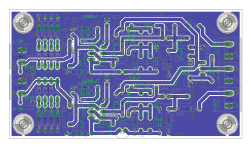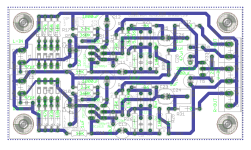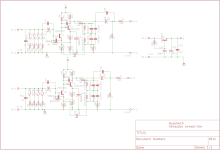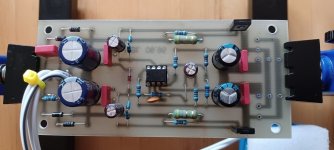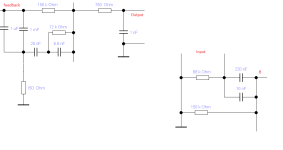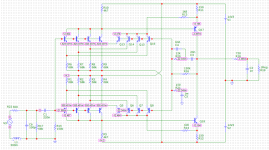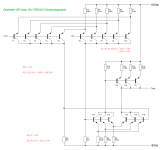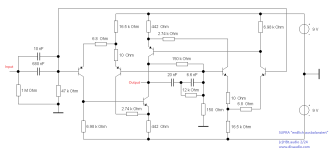You've got that mixed up,Oread-lite is almost identical to the old Realistic-42-2101A as found on the internet
but it doesn't matter - if you now deliver the real light version of this thread.
😉
Dear 'quadtech'!
I think the enthusiasm is great, what do you think about implementing the PSU from my posting #150 in EAGLE? However, you must check the function first.
The fantastic layout from "catd" is already available for our open joint project - and I'm counting on it.
HBt.
I think the enthusiasm is great, what do you think about implementing the PSU from my posting #150 in EAGLE? However, you must check the function first.
The fantastic layout from "catd" is already available for our open joint project - and I'm counting on it.
HBt.
it doesn't matter - if you now deliver the real light version of this thread.
😉
The real deal I hope, this time 🙂
Attachments
C7, C8, C9, C10 have no place on the PCB, they are counterproductive!
What components and component values do you want to make up the negative feedback network?
The values listed are academic in nature, they are the calculated values - you are still faced with choosing the right component.
I also recommend using the 120kOhm resistor and foregoing the variable input resistance selection using a DIP switch!
What components and component values do you want to make up the negative feedback network?
The values listed are academic in nature, they are the calculated values - you are still faced with choosing the right component.
I also recommend using the 120kOhm resistor and foregoing the variable input resistance selection using a DIP switch!
Do us a favor: please remove my name from the board and the drawing, instead refer to the forum "www.diyaudio.com" - if there are commercial intentions, consider the warranty... etc.pp.
😉
It would be interesting to compare the two existing dimensions, as the topology, philosophy and working methods are almost identical.
Which circuit is most popular with listeners? And to put it more technically: why is that so?
I'm currently working on a suitable power supply for my overkill 19 transistor OREAD MM EQ. As is well known, the power consumption is very low - and therefore the battery supply in particular could ...
Regards,
HBt.
😉
It would be interesting to compare the two existing dimensions, as the topology, philosophy and working methods are almost identical.
Which circuit is most popular with listeners? And to put it more technically: why is that so?
I'm currently working on a suitable power supply for my overkill 19 transistor OREAD MM EQ. As is well known, the power consumption is very low - and therefore the battery supply in particular could ...
Regards,
HBt.
Last edited:
As much as i appreciate the commitment and the fascination, we should all now dedicate this thread exclusively to the realization of the OREAD (whose namesake is Chestnutspread). Not a possible lite or light version. The discrete two-stage operational amplifier (the core of the EQ) already offers countless possibilities in the implementation - we should now concentrate on that.
The core alone has 4 basic implementations; nothing has been decided about the most sensible component selection, which also depends on personal taste - everything is open.
The "catd PCB" will be assembled and tested sometime in April - that will be the litmus test.
The core alone has 4 basic implementations; nothing has been decided about the most sensible component selection, which also depends on personal taste - everything is open.
The "catd PCB" will be assembled and tested sometime in April - that will be the litmus test.
While tidying up yesterday, I happened to find an old etched circuit board of mine. In keeping with the motto of this thread, I assembled it today using mostly free components from the tinkering box. There was also a tiny 5VA mains transformer on the shelf, so what's the point? After all, OREAD is not a real load for the power supply.
The no-load case will correspond approximately to the load case, heat sinks are not necessary ---> a 2 x 12Vac, 5VA mains transformer will also do the job.

This is what I will ultimately use to operate /power the EQ. But the whole thing is nothing more than a coincidence.
The no-load case will correspond approximately to the load case, heat sinks are not necessary ---> a 2 x 12Vac, 5VA mains transformer will also do the job.
This is what I will ultimately use to operate /power the EQ. But the whole thing is nothing more than a coincidence.
Attachments
@catd,
I have just set up a new simulation - and played with the SUPRA again. Why don't you simulate with the following changes (a coupling capacitor at the output or a servo circuit is not required) 😉.
re is now 47kOhm || 13.1pF !
HBt.
I have just set up a new simulation - and played with the SUPRA again. Why don't you simulate with the following changes (a coupling capacitor at the output or a servo circuit is not required) 😉.
re is now 47kOhm || 13.1pF !
HBt.
Attachments
Last edited:
I am contemplating a SMD version of this. The selection of components are better than trough hole, input transistors could be BC860C or MMBT5087, resistors are 0207 MELF for lowest noise, RIAA capacitors 1% NP0 ceramic, it would look something like this.

This is not finished at all, no promises 😉
This is not finished at all, no promises 😉
A note on the power supply circuit:
I took the circuit principle from the fabulous Technics SU-VX800 amplifier. It was nothing new even back then, but still quite interesting - probably because of the advertising department of Matsushita / Japan.
The way it works is self-explanatory.
I took the circuit principle from the fabulous Technics SU-VX800 amplifier. It was nothing new even back then, but still quite interesting - probably because of the advertising department of Matsushita / Japan.
The way it works is self-explanatory.
Because it popped up recently, I'll dig it up again in conclusion.Thanks for digging this up. Unfortunately, abgeschlossenem means terminated, so you still don't know anything when they don't tell you what they terminated it with...
I loaded the SUPRA schematic into Mikro-Cap12 and compared it with my ancient PCSpice, among other things. The simulation results are almost identical - and therefore the worst results at the end:
Cin << 28pf
SNR > 85dB rated ( < 88dB !)
I used 500mH + 500Ohm (with 47k || 100pF (+22pF)) as the source. For me, this puts an end to all disputes (including the correct termination of an MM cartridge).
I hope we are now making rapid progress with the OREAD example.
@catd
Dear Markus,
will you let us know when the circuit boards have arrived?
Greetings,
HBt.
Attachments
Last edited:
Ja sicher, was denkst Du denn?@catd
Dear Markus,
will you let us know when the circuit boards have arrived?
Yes, sure, what do you think?
🙂
Maybe you should also post these 'final' SUPRA values in the SUPRA thread so that this is clarified for those who aren't reading here.
Nice PCB. But when it comes to SMD, DIY is over for me. There's no way I'm messing around with these almost invisible parts. 😉I am contemplating a SMD version of this.
If you offered a fully assembled board...maybe. It's probably better to wait with the SMD effort until we've tested the thing with the "normal" board and everything is OK with the circuit.
But...But.... I used gigantic components! 0207 Melf is enormous SOT23 also, and the capacitors are 1210 and i chose the extra large hand soldering pads! Having worked for over 20 years in electronics development and testing my perspective may be a little different than the usual DIY audio builder but for me the real difficulty begins with the sizes smaller than 0402, then you need a real microscope to see anything.
The PCB is what i threw together to see what it may look like and it is also nice to have a started project in KiCad it makes it easier to remember what the initial thoughts were if I want to go further. As I understand there is no final version with the component values set, I will wait for real life results, and please let it be E12 values 😉
The PCB is what i threw together to see what it may look like and it is also nice to have a started project in KiCad it makes it easier to remember what the initial thoughts were if I want to go further. As I understand there is no final version with the component values set, I will wait for real life results, and please let it be E12 values 😉
I would also be enthusiastic about a nice, handy but easy-to-use SMD PCP - if old dodderers could handle it. I can't do much without reading glasses and a magnifying glass.
TH components can also be packed quite tightly, but a shielding copper layer must not be missing.
😉
At least T1 to T10 should be selected for maximum Hfe and matched / paired ..!
TH components can also be packed quite tightly, but a shielding copper layer must not be missing.
😉
At least T1 to T10 should be selected for maximum Hfe and matched / paired ..!
Attachments
Last edited:
In addition to shielding, it is also (always) a good idea to ensure a thermal balance between the pairs.
Hi...
I just received information that the OREAD PCBs have been shipped.
I assume that it will now take around 14 days, including customs, for the package to reach me.
...
thermal balance:
When I was working with the SUPRA some time ago and, for example, measuring the output voltage offset, I noticed an irregular but persistent +/- fluctuation around the zero point of a few 100µV. It took some time before I realized that I myself was the cause, namely my breath, which was passing over the circuit board and thereby irregularly affecting the temperature of the transistors. In a housing without air movement the “problem” disappears. When testing a board without a case, you can place a towel or something similar over it if necessary. It will probably be similar with the OREAD
I just received information that the OREAD PCBs have been shipped.
I assume that it will now take around 14 days, including customs, for the package to reach me.
...
thermal balance:
When I was working with the SUPRA some time ago and, for example, measuring the output voltage offset, I noticed an irregular but persistent +/- fluctuation around the zero point of a few 100µV. It took some time before I realized that I myself was the cause, namely my breath, which was passing over the circuit board and thereby irregularly affecting the temperature of the transistors. In a housing without air movement the “problem” disappears. When testing a board without a case, you can place a towel or something similar over it if necessary. It will probably be similar with the OREAD
Maybe you should also post these 'final' SUPRA values in the SUPRA thread so that this is clarified for those who aren't reading here.
Oh, that's what I had (also) in mind, but now we're here in this thread - and that's where I'm staying.
SUPRA without end
Marcel's objections don't let me rest, because he's basically right about the optimum quiescent current - unfortunately, Nick isn't entirely wrong either. However, explaining these points here would go too far, at least in this thread.
My day yesterday was all about practical testing, i.e. I completely rebuilt a SUPRA in stereo - but without the parallel connection of the individual transistors. Consequently, a large current of 2 * 500µA is now flowing ... the four 68kOhm resistors give way to a 13k7Ohm. Apart from that, the breadboard structure is identical to the dimensioning in posting #192.
I was concerned with a) the sound and b) the nature of the noise. Well, it's sobering and intoxicating. Quieting this test setup is not easy, the core, i.e. the actual amplifier - is extremely sensitive, sensitive to somehow everything.
The positive side first:
the sound is free and very natural, unstrained - the noise is colorful, as it should be, dark.
You can hear it sparkle, shoot and pop - if you're unlucky, yes.
The negative at the not exactly insignificant beginning of the end:
You need an absolutely hum-free supply voltage and super duper shielding, much will be due to my disastrous test setup, but not all.
That was a very hard 12-hour working day, with the result -> the SUPRA1982 absolutely needs the parallel connection and also the active filtering of the rails.
As a single core, "the symmetrical amp" is not really suitable for MM systems.
No sooner said than done, "think, calculate, simulate ..."
the current must be lowered at least until everything is really stable and no disturbing, physical semiconductor artifacts become audible. By audible, I mean via a fully turned up headphone amplifier and headphones. So that you can spend a whole hour just listening to the noise.
And I'm not giving up that easily, so here's a much better balanced version of the single SUPRA.
But why am I writing this here in the OREAD thread after all? Because there's still a lot to do. Only a final test setup with Catd's universal board in a housing will show us where there are still open issues.
But first of all, if you don't want to corrupt the low bass and bass range, you shouldn't load this type of circuitry (including the Nick Wonder EQ). A subsequent load of even 10kOhms will have a negative effect on the sound foundation ---> a possible solution can be found in the schematic of PEARL 3, but a simple buffer will also do. This will be decided later. Here you have to measure.
Regards,
HBt.
Attachments
Last edited:
- Home
- Source & Line
- Analogue Source
- Oread - a DIY MM phono approach
